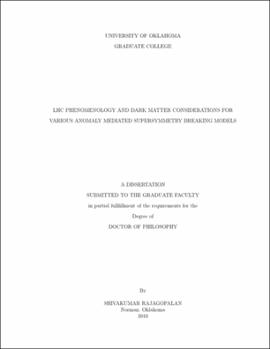| dc.contributor.advisor | Baer, Howard A | |
| dc.creator | Rajagopalan, Shivakumar | |
| dc.date.accessioned | 2019-04-27T21:28:44Z | |
| dc.date.available | 2019-04-27T21:28:44Z | |
| dc.date.issued | 2010 | |
| dc.identifier | 99224823002042 | |
| dc.identifier.uri | https://hdl.handle.net/11244/318782 | |
| dc.description.abstract | In this thesis we examine three different models in the MSSM context, all of which have significant supergravity anomaly contributions to their soft masses. These models are the so-called Minimal, Hypercharged, and Gaugino Anomaly Mediated Supersymmetry Breaking models. We explore some of the string theoretical motivations for these models and proceed by understanding how they would appear at the Large Hadron Collider (LHC). Our major results include calculating the LHC reach for each model's parameter space and prescribing a method for distinguishing the models after the collection of 100 fb^(−1) at s^(1/2) = 14 TeV. AMSB models are notorious for predicting too low a dark matter relic density. To counter this argument we explore several proposed mechanisms for non-thermal dark matter production that act to augment abundances from the usual thermal calculations. Interestingly, we find that future direct detection dark matter experiments potentially have a much better reach than the LHC for these models. | |
| dc.format.extent | 160 pages | |
| dc.format.medium | application.pdf | |
| dc.language | en_US | |
| dc.relation.requires | Adobe Acrobat Reader | |
| dc.subject | Large Hadron Collider (France and Switzerland) | |
| dc.subject | Phenomenology | |
| dc.subject | Particles (Nuclear physics) | |
| dc.subject | Supersymmetry | |
| dc.subject | Dark matter (Astronomy) | |
| dc.title | LHC Phenomenology and Dark Matter Considerations for Various Anomaly Mediated Supersymmetry Breaking Models | |
| dc.type | text | |
| dc.type | document | |
| dc.thesis.degree | Ph.D. | |
| ou.group | College of Arts and Sciences::Homer L. Dodge Department of Physics and Astronomy | |
